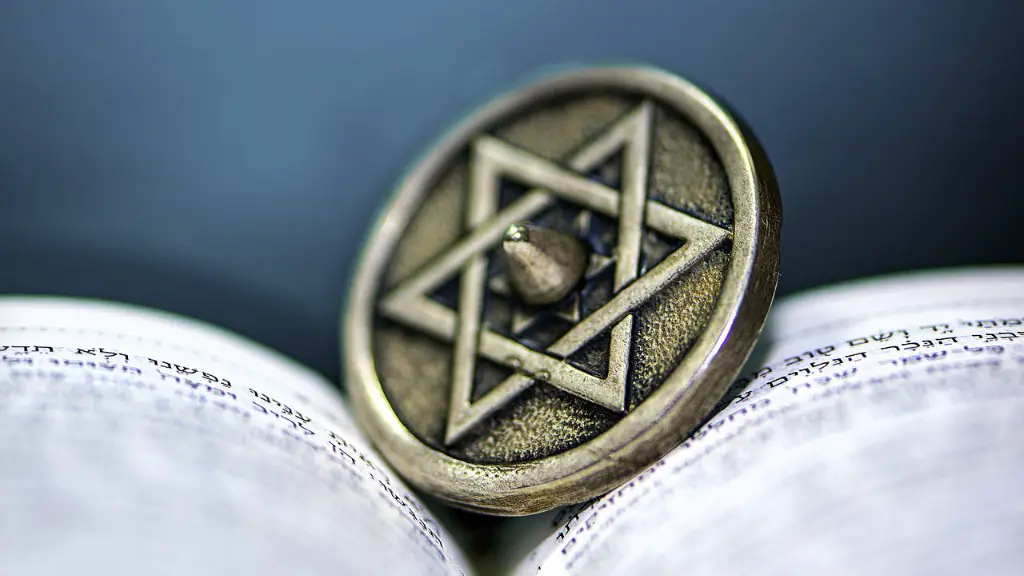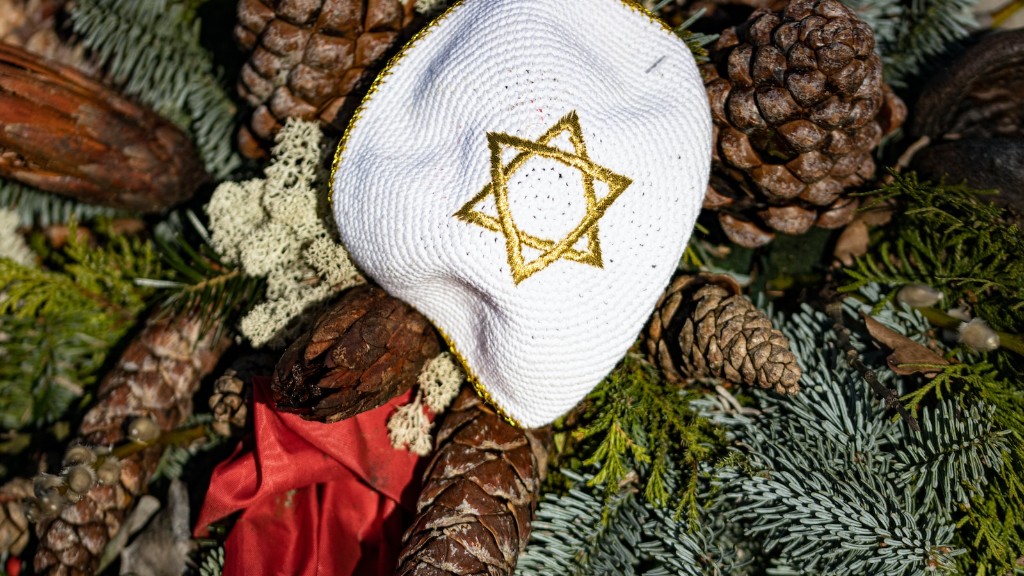What is a kippah? It is a religious head covering worn by Jewish men and boys as a sign of respect and obedience to the traditions of their faith. It is also known as a yarmulke or kippot, and is often worn during services, when leading prayers and when taking part in Jewish ceremonies. Wearing a kippah is an ancient Jewish practice, and symbolizes humility before God.
Kippah originates from the Hebrew word ‘kippa’ which means “dome”. Traditionally, Jews would wear kippahs made of cloth during prayer services. Today, kippahs come in a variety of shapes, sizes and colors and can be worn for a variety of reasons. Some Jews may choose to wear a kippah to show respect for their faith, while others may choose to wear a kippah to show solidarity with their community.Whatever the reasons, wearing a kippah is an outward sign of Jewish identity and pride among the Jewish people.
In Orthodox Judaism, it is traditional for married men to always wear a kippah when in public, even when outside of the synagogue or other place of worship. For many Orthodox Jews, it is considered unseemly to be seen without covering one’s head. Wearing a kippah is seen as an outward sign of modesty, respect, and humility before God. In modern times, many Reform and Conservative Jews also choose to always wear a kippah when in public, but it is not always a requirement.
When it comes to selecting a kippah for different occasions, there are some general guidelines. For Orthodox Jews, plain colors are often preferred, but there is some variety in color and style. For Conservative and Reform Jews, there are more freedom in terms of colors and patterns, depending on personal preference. Kippahs can also be embroidered with scriptures, quotes or images, but it is important to remember that the basic shape of the kippah should always remain the same.
Overall, wearing a kippah is a very important part of the Jewish faith and culture. It is an outward sign of respect and humility before God, and reminds us to act judiciously and with integrity in our life. Furthermore, wearing a kippah can be a symbol of solidarity and pride among the Jewish community and can be a powerful statement and reminder of their shared history and traditions.
Kippah Cultural Perspectives
Kippah has a long-standing cultural significance, particularly in Orthodox Judaism, but is becoming increasingly popular in the wider Jewish community in recent years. For example, in some Reform and Conservative communities, it is now more common to see kippahs worn, even outside of synagogue services. Kippahs of varying styles and colors can also be seen in more progressive societies and organizations, where they are seen as a sign of inclusion and respect to all.
Furthermore, kippahs can also serve as a reminder of the importance of Jewish community and solidarity. By wearing a kippah, individuals are showing respect to their faith and reminding others of the shared history and values that connect all Jews, no matter the denomination.Kippah is also a powerful symbol of identity, connecting individuals to their culture and to a shared past. By wearing a kippah, individuals are saying, “This is who I am, and this is a part of my identity.”
Kippah Ethics
Wearing a kippah is a way of expressing humility and recognizing the Divine Presence in everyday life. It is an outward sign of respect for one’s faith and commitment to following Jewish law and traditions. Furthermore, it serves as an important reminder of values such as modesty and justice, while promoting a sense of empathy, respect, and understanding among individuals and within society as a whole.
In addition, some may choose to wear a kippah to express support for the suffering of fellow Jews and to show solidarity with persecuted communities throughout history. Wearing a kippah is also a way of outspokenly stating one’s beliefs and dedication to their faith, even in the face of social and political pressures. Finally, it can serve as a reminder of the importance of standing up against injustice and violence.
Kippah Fashion
In recent years, kippahs have become increasingly fashionable and visible in mainstream society. There is a growing trend of fashion-forward kippahs that come in a wide variety of colors and styles, from traditional to modern. Kippahs of all shapes, sizes, and colors are available for sale online and in stores, and there are even designers specializing in creating chic custom kippahs for special events or everyday wear.
Additionally, kippah is becoming increasingly popular in the wider fashion and lifestyle industries. For example, there has been a rise in collaborations between fashion brands and kippah-makers. This has resulted in a wide range of stylish and fashionable kippahs that are becoming increasingly popular among young people and in the public sphere.
Overall,kippah is a powerful symbol and an important part of the Jewish faith and culture. It serves as an outward sign of respect, humility and solidarity among the Jewish people, and has become increasingly popular in recent years, both in terms of its cultural and fashion significance.
Kippah And Gender
In Orthodox Judaism, the wearing of a kippah has historically been a practice for married men only. This is often seen as a sign of respect for the traditions and laws of Orthodox Judaism, as well as a reminder of traditional gender roles. In recent years, however, this has become less of a requirement, and there are now many Reform and Conservative Jewish people who wear a kippah for religious and personal reasons, regardless of gender.
Furthermore, some individuals may choose to wear a kippah to display their gender identity and expression. This can be especially meaningful for those who may not conventionally identify as either males or females, or those who may feel restricted by traditional gender roles. By wearing a kippah, they are creating a space to express themselves in their own way and be accepted and respected in their communities.
Overall, kippah is a powerful symbol of identity and pride for the Jewish community. As such, it has become increasingly popular in recent years, and the guidelines for who is eligible to wear a kippah have broadened. For some individuals, wearing a kippah is a way of expressing their faith and their gender identity and expression.
Kippah In Modern Society
In recent years, kippahs have become visible beyond the religious realm, and are now commonplace in mainstream society. This is particularly true in areas with high concentrations of observant Jews, where kippahs can be seen in a variety of everyday contexts and settings. For example, it is not uncommon to see people wearing kippahs while attending school, shopping at the mall, or attending public events.
This increased visibility of kippah has led to perceptions that are not always positive. In some cases, kippah has become a symbol of exclusion and harassment, and there have been reports of anti-Semitic abuse and bullying targeted at people wearing a kippah. It is important to note that wearing a kippah does not automatically signify acceptance of any offensive or inappropriate behavior, and it does not give anyone the permission or ability to treat someone with disrespect.
Furthermore, some have argued that the increasing visibility of kippahs has also led to points of tension between Jews and non-Jews. While this may be true in some cases, it is also important to recognize the power of kippah to serve as a symbol of inclusion, respect and understanding. Through increased dialogue and education, it is possible to build bridges of understanding between different religious and cultural communities.
In conclusion, kippah is a powerful symbol of faith, identity, and pride for the Jewish community. It serves as an outward sign of respect and humility before God, and is a reminder of shared values, traditions and history. While it is gaining popularity in mainstream society, it is also important to remember that kippahs can also be seen as a symbol of exclusion, harassment and tension. Through dialogue and education, it is possible to build bridges of understanding between different religious and cultural communities.



